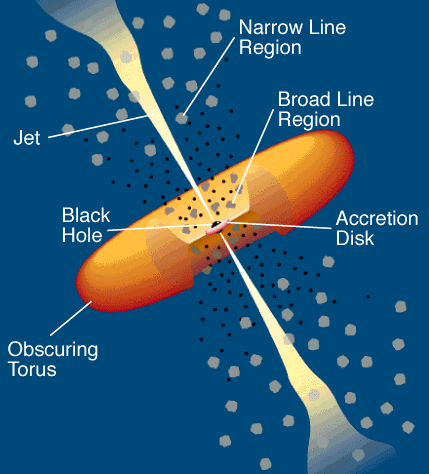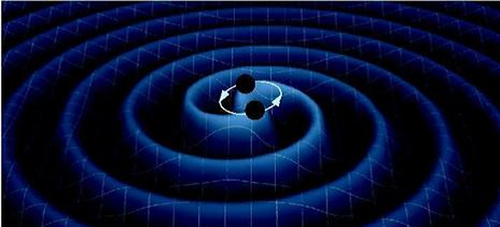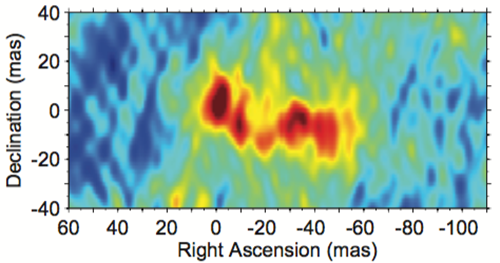Zooming into the heart of candidate binary black holes with powerful radio techniques: only singles, no pairs
[June 8, 2016] An international research team discovered single radio-luminous black holes from candidate binaries with powerful highest-resolution imaging techniques. This result implies that pairs of active galactic nuclei are harder to find than astronomers thought.
The supermassive black hole (up to billions of solar masses) residing in the heart of the active galaxy is accreting material from its surroundings, and releasing a vast amount of radiation, making it extremely bright in the whole electromagnetic spectrum. The infalling material forms an accretion disk around the black hole. Moving clouds of ionised material form the so-called narrow-line and broad-line regions around the central source. In the case of about 10% of the galaxies with active black holes, highly relativistic jets are formed perpendicular to the disk. Also powerful outflows and winds are often observed.

Figure 1. A sketch of an active black hole and its surroudings. (Illustration: C.M. Urry and P. Padovani)
According to the hierarchical galaxy formation models, massive galaxies grew through merging of smaller ones. At the final phases of a galaxy merger, astronomers expect to see binary black holes in their centers. Such coalescing massive black holes are the targets of the long-planned space-borne gravitational wave detector eLISA. Presently, however, astronomers have to mostly rely on electromagnetic signatures to find close pairs of black holes.

Figure 2. A sketch of coalescing black holes. (Illustration: NASA / JPL)
Simulations show that collisions and interactions of galaxies may initiate activity of the central black hole; specifically at the earlier evolutionary stage of a galaxy merger, pairs of black holes at separations of a few thousands of light year are expected to form. However, compared to theoretical predictions and the detections of thousands of galaxy pairs, only a few tens of such double black holes are known to date. It was proposed that double-peaked narrow optical emission lines can signify the presence of double black holes at these separations, where the two spectral peaks originate from the two distinct narrow-line regions of the two black holes. Comerford et al. (2012, Astrophysical Journal, 753: 42-53) proposed additional selection criteria to narrow down the list of double black hole candidates from the group of galaxies showing double-peaked lines using long-slit spectroscopic observations to determine the position angle and compactness of the emission features. From their list of compelling double black hole candidates, an international research team consisting of scientists from China, Hungary, the Netherlands, and Germany selected the four brightest in radio band.
The radio observations made use of a technique called very long baseline interferometry (VLBI) providing the best angular resolution among all astronomical imaging techniques to date. It enables astronomers to disentangle the compact radio emission originating from the vicinity of double black holes from the emission further down the jet.
The observations were conducted with the U.S. Very Long Baseline Array (VLBA) and detected three sources out of the targeted four showing different morphologies. All three radio sources contain a single compact source corresponding to a single radio-emitting nucleus. Figure 3 shows the radio image of the brightest galactic nucleus SDSS J23044.82-093345.3, which appears as a single black hole with a continuous jet toward the right. In this galaxy, the possibility of a secondary radio-emitting black hole in the position suggested by the optical spectroscopic data can be safely excluded. In two other galaxies, the position angles of the radio structures are very similar to the position angles of the detected optical emission features, which indicates that the double-peaked emission lines may originate in these sources from jet-driven outflows instead of double black holes.

Figure 3: The 1.5 GHz VLBA map of SDSS J23044.82-093345.3 showing a single active black hole with a continuous jet structure extended to 125 light-years.
The absence of radio-emitting black hole pairs from these observations is an argument against the presence of radio-luminous double black holes in optically peculiar galaxies. This research indicates that double-peaked line systems, even with some additional selection criteria, are in general not excellent candidates for real black hole pairs.
Pairs of active black holes are harder to find than astronomers thought. Achieving the required imaging sensitivity and resolution to completely verify or rule out the existence of pairs of black holes in a peculiar merging galaxy requires ample amount of observing time (preferably at more than one frequency), thus the Square Kilometre Array (in short, SKA), when fully deployed, would have the powerful survey efficiency, sufficient sensitivity and high resolution to detect double black holes with separations less than about 1000 light year, in principle at all cosmic distances. Moreover, the SKA as an element of a VLBI array could identify even tighter black hole pairs at light year-scale separations.
The results are accepted for publication in the Astrophysical Journal. The details of this work may be found in the preprint at http://arxiv.org/abs/1605.09188 “Four dual AGN candidates observed with the VLBA” . The team consists of scientists from the Shanghai Astronomical Observatory (China), F?MI Satellite Geodetic Observatory (Hungary), Joint Institute for VLBI ERIC (the Netherlands) and the Max Planck Institute for Radio Astronomy (Germany). The study was partly supported by the China-Hungary Collaboration and Exchange Programme by the International Cooperation Bureau of the Chinese Academy of Sciences.
Download attachments:


